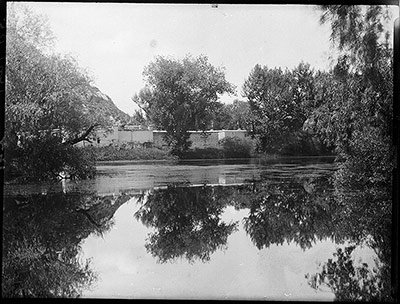
1998.286.252 (Glass negative)


1998.286.252 (Glass negative)

Sir Charles Bell or Rabden Lepcha?
Sir Charles Bell
September 22nd 1921?
Lhasa > Lukhang
1998.286.252
78 x 103 mm
Negative Quarter Plate
Donated 1983
St Antony's College, Oxford
Sir Charles Bell's Mission to Lhasa 1920-21
Q.241
BL.Q.241
British Library, Oriental and India Office Collections
'The People of Tibet', Sir Charles Bell, Oxford: Clarendon Press, 1928 [view list of illustrations]
Manual Catalogues - Bell's List of Illustrations entry: "[No. of chapter] L. [Subject of Chapter] Lhasa [Subject of Illustration] Q241 (ax) Grounds of the Serpent Temple (Luknag) behind the Potala, with poplar trees reflected in the pond."
Contemporary Publication - Published in 'The People of Tibet', Bell, C. A., Oxford: Clarendon Press, 1928, facing p.130:"Grounds of the serpent temple. Regarded by the Chinese as one of the five beauties of Lhasa." [MS 10/9/2004]
Other Information - Cultural Background: Bell's Diary entry for 9th June:"There are two kinds of poplar trees in Lhasa; one like the kind at Gyantse; the other different to any poplar in Gyantse, the Chumbi Valley or Sikkim. The wood of the second kind somewhat resembles that of the poplar in Sikkim and the Chumbi Valley but the leaves are smaller and shaped more like the leaves of a maple. This kind is called "White Poplar" ( ja - kar ) [Tibetan script] in Lhasa. // It is used for house pillars, though soft, because it is easily carved with the designs appropriate to such pillars. Neto Jongpen thinks it is indigenous to Tibet, for he says the wood is rather poor and it would not have been worthwhile to introduce it from China or elsewhere. I do not remember to have seen it anywhere in India." [Diary Vol. XI., p.1]
Other Information - Dates: Bell comments in his Diary for September 22nd 1921 that on this day he visited the Lu Temple [ Lukhang ] behind Potala with Tsendron and wrote an extensive description. He also comments that only on the 15th day of the 4th Tibetan month is the temple opened to the public - to visit at any other time requires the special permission of the Dalai Lama [Diary Vol. XIII, pp. 1-5] [MS 06/03/2006]
For Citation use:
The Tibet Album.
"Lukhang behind the Potala"
05 Dec. 2006. The Pitt Rivers Museum.
<http://tibet.prm.ox.ac.uk/photo_1998.286.252.html>.
For more information about photographic usage or to order prints, please visit the The Pitt Rivers Museum.
© The Pitt Rivers Museum